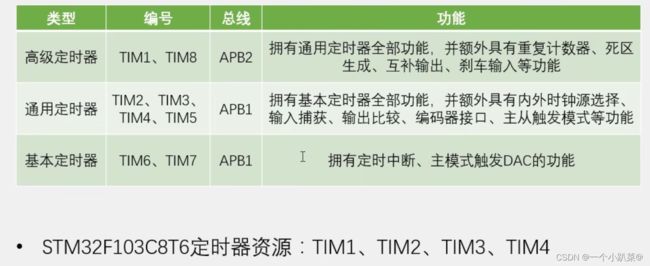STM32—TIM:基本定时器(定时中断)(标准库)
STM32的定时器分为基本定时器,通用定时器,高级定时器,定时器功能逐渐增加,具体功能如下:
定时中断功能讲解:
外设使能:void RCC_APB1PeriphClockCmd(uint32_t RCC_APB1Periph, FunctionalState NewState)
/**
* @brief Enables or disables the Low Speed APB (APB1) peripheral clock.
* @param RCC_APB1Periph: specifies the APB1 peripheral to gates its clock.
* This parameter can be any combination of the following values:
* @arg RCC_APB1Periph_TIM2, RCC_APB1Periph_TIM3, RCC_APB1Periph_TIM4,
* RCC_APB1Periph_TIM5, RCC_APB1Periph_TIM6, RCC_APB1Periph_TIM7,
* RCC_APB1Periph_WWDG, RCC_APB1Periph_SPI2, RCC_APB1Periph_SPI3,
* RCC_APB1Periph_USART2, RCC_APB1Periph_USART3, RCC_APB1Periph_USART4,
* RCC_APB1Periph_USART5, RCC_APB1Periph_I2C1, RCC_APB1Periph_I2C2,
* RCC_APB1Periph_USB, RCC_APB1Periph_CAN1, RCC_APB1Periph_BKP,
* RCC_APB1Periph_PWR, RCC_APB1Periph_DAC, RCC_APB1Periph_CEC,
* RCC_APB1Periph_TIM12, RCC_APB1Periph_TIM13, RCC_APB1Periph_TIM14
* @param NewState: new state of the specified peripheral clock.
* This parameter can be: ENABLE or DISABLE.
* @retval None
*/
void RCC_APB1PeriphClockCmd(uint32_t RCC_APB1Periph, FunctionalState NewState)
{
........
}配置内部时钟:void TIM_InternalClockConfig(TIM_TypeDef* TIMx) (定时器的时钟可选内部和外部)
/**
* @brief Configures the TIMx internal Clock
* @param TIMx: where x can be 1, 2, 3, 4, 5, 8, 9, 12 or 15
* to select the TIM peripheral.
* @retval None
*/
void TIM_InternalClockConfig(TIM_TypeDef* TIMx)
{
............
}定时器配置初始化:void TIM_TimeBaseInit(TIM_TypeDef* TIMx, TIM_TimeBaseInitTypeDef* TIM_TimeBaseInitStruct)
/**
* @brief Initializes the TIMx Time Base Unit peripheral according to
* the specified parameters in the TIM_TimeBaseInitStruct.
* @param TIMx: where x can be 1 to 17 to select the TIM peripheral.
* @param TIM_TimeBaseInitStruct: pointer to a TIM_TimeBaseInitTypeDef
* structure that contains the configuration information for the
* specified TIM peripheral.
* @retval None
*/
void TIM_TimeBaseInit(TIM_TypeDef* TIMx, TIM_TimeBaseInitTypeDef* TIM_TimeBaseInitStruct)
{
............
}
// TIM_TimeBaseInitStruct.TIM_ClockDivision 配置分频器
// TIM_TimeBaseInitStruct.TIM_CounterMode 配置计数模式
// TIM_TimeBaseInitStruct.TIM_Period 配置ARR自动重装器 (0~65535)
// TIM_TimeBaseInitStruct.TIM_Prescaler 配置PSC预分频器 (0~65535)
// TIM_TimeBaseInitStruct.TIM_RepetitionCounter 配置重复寄存器
注意:TIM_TimeBaseInitStruct.TIM_RepetitionCounter 是高级定时器特有参数,如不使用高级定时器
可将这参数置为0
时间计算:
CK_CNT_OV = CK_CNT/(ARR+1) = CK_PSC/(PCS+1)/(ARR+1)
解释:
CK_CNT_OV : 计数频率
CK_CNT :计数器 ARR : 自动重装器
CK_PSC :时钟频率(一般STM32为72MHZ) PCS : 预分频器
举例:如果要定时1s : 则 CK_CNT_OV 为1HZ 则 72000000/(PCS+1)/(ARR+1) = 1
就可以选择 PCS = 7200-1 ARR = 10000-1
如果要定时1ms : 则 CK_CNT_OV 为1000HZ 则 72000000/(PCS+1)/(ARR+1) = 1000
就可以选择 PCS = 7200-1 ARR = 10-1
如果要定时5ms : 则 CK_CNT_OV 为200HZ 则 72000000/(PCS+1)/(ARR+1) = 200
就可以选择 PCS = 7200-1 ARR = 50-1
使能定时器中断:void TIM_ITConfig(TIM_TypeDef* TIMx, uint16_t TIM_IT, FunctionalState NewState)
/**
* @brief Enables or disables the specified TIM interrupts.
* @param TIMx: where x can be 1 to 17 to select the TIMx peripheral.
* @param TIM_IT: specifies the TIM interrupts sources to be enabled or disabled.
* This parameter can be any combination of the following values:
* @arg TIM_IT_Update: TIM update Interrupt source
* @arg TIM_IT_CC1: TIM Capture Compare 1 Interrupt source
* @arg TIM_IT_CC2: TIM Capture Compare 2 Interrupt source
* @arg TIM_IT_CC3: TIM Capture Compare 3 Interrupt source
* @arg TIM_IT_CC4: TIM Capture Compare 4 Interrupt source
* @arg TIM_IT_COM: TIM Commutation Interrupt source
* @arg TIM_IT_Trigger: TIM Trigger Interrupt source
* @arg TIM_IT_Break: TIM Break Interrupt source
* @note
* - TIM6 and TIM7 can only generate an update interrupt.
* - TIM9, TIM12 and TIM15 can have only TIM_IT_Update, TIM_IT_CC1,
* TIM_IT_CC2 or TIM_IT_Trigger.
* - TIM10, TIM11, TIM13, TIM14, TIM16 and TIM17 can have TIM_IT_Update or TIM_IT_CC1.
* - TIM_IT_Break is used only with TIM1, TIM8 and TIM15.
* - TIM_IT_COM is used only with TIM1, TIM8, TIM15, TIM16 and TIM17.
* @param NewState: new state of the TIM interrupts.
* This parameter can be: ENABLE or DISABLE.
* @retval None
*/
void TIM_ITConfig(TIM_TypeDef* TIMx, uint16_t TIM_IT, FunctionalState NewState)
{
................
}配置NVIC: void NVIC_Init(NVIC_InitTypeDef* NVIC_InitStruct)
/**
* @brief Initializes the NVIC peripheral according to the specified
* parameters in the NVIC_InitStruct.
* @param NVIC_InitStruct: pointer to a NVIC_InitTypeDef structure that contains
* the configuration information for the specified NVIC peripheral.
* @retval None
*/
void NVIC_Init(NVIC_InitTypeDef* NVIC_InitStruct)
{
.................
}
注意:配置NVIC必须先进行NVIC分组,且NVIC分组一旦设定就不可被更改
NVIC分组函数:
void NVIC_PriorityGroupConfig();使能定时器:void TIM_Cmd(TIM_TypeDef* TIMx, FunctionalState NewState);
/**
* @brief Enables or disables the specified TIM peripheral.
* @param TIMx: where x can be 1 to 17 to select the TIMx peripheral.
* @param NewState: new state of the TIMx peripheral.
* This parameter can be: ENABLE or DISABLE.
* @retval None
*/
void TIM_Cmd(TIM_TypeDef* TIMx, FunctionalState NewState)
{
......
}
这样定时器就会开始定时中断
配置中断函数:STM32的中断函数都是封装好了的
在启动文件 
选择定时器的中断函数(以定时器1为例子)
void TIM6_IRQHandler(void)
{
if(TIM_GetFlagStatus(TIM6,TIM_FLAG_Update) == SET)
{
TIM_ClearITPendingBit(TIM6,TIM_FLAG_Update);
}
}
void TIM_GetFlagStatus() : 获取TIMx的某个标志位
此函数的目的是有的中断函数有着多个中断源,需要进行区分。
void TIM_ClearITPendingBit() : 清除TIMx的某个标志位注意:若按照上面进行TIM的配置,则会在这里出现一个小问题
void TIM_TimeBaseInit();
使用这函数的时候定时器的中断挂起位会被置1(即申请一个更新事件)
此时一旦使能中断就会立马进入一次中断
这显然不是我们想要的
所以在中断使能之前我们需要人为清除这个函数所产生的中断
TIM_ClearITPendingBit(TIM6,TIM_FLAG_Update);